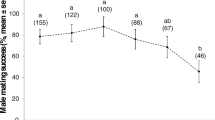Abstract
Males of the Triatominae, Panstrongylus megistus and Triatoma infestons, show a considerable difference concerning the time necessary for them to acquire the capacity for the first mating. P. megistus copulates from the eighth day of adult life, irrespective of whether or not it has been fed, while T. infestons copulates about 17 days after the imaginai moult and only after a blood-meal. These differences might be due to the secretory activity of T. infestons male accessory glands whose full development is reached only after two saturant blood-meals. If allatectomy is performed in male P. megistus soon after the imaginai moult, accumulation of secretion does not occur in 3 of the 4 accessory glands. Topical application of precocene II (200/ig/insect)a few days before or soon after the imaginai moult in P. megistus, halves the amount of secretion in the accessory glands.
Résumé
Les mâles des Triatomidés Panstrongylus megistus et Triatoma infestans, présentent une différence considerable en ce qui concerne le temps nécessaire à l’acquisition de la capacité pour réaliser le premier accouplement. Chez P. megistus le mâle devient apte à s’accoupler 8 jours après la mue imagínale, indépendamment de la prise de repas sanguin, tandis que le mâle de T. infestans ne s’accouple qu’après le 17ème jour après l’émergence, et cela sous la dependence du repas sanguin. Cette différence est due à l’activité sécrétoire des glandes accessoires dont le complet développement chez T. infestans n’a pas lieu qu’après la pise de 2 repas saturants. L’allatectomie pratiquée tout de suite apès la mue imagínale chez le mâle de P. megistus résulte en blockage de l’activité sécrétoire chez 3 des 4 glandes accessoires. L’application topique de 200 μg/insect de precocène II quelques jours avant ou tout de suite après la mue imaginale chez cette espèce, reduit considérablement l’accumulation des sécrétions dans les glandes accessoires.
Similar content being viewed by others
References
Barker J. F. and Davey K. G. (1981) Neuroendocrine regulation of protein accumulation by the transparent accessory reproductive glands of male Rhodnius prolixus. Int. J. invertebr. Reprod. 3, 290–296.
Barth R. (1955) Estudos anatómicos e histológicos sobre a subfamilia Triatominae (Heteroptera: Reduviidae). V parte: Anatomia do testículo e espermiocitogênese de T. infestons. Memor. Inst. Oswaldo Cruz. 54, 694–701.
Blaine N. D. and Dixon S. E. (1973) The effect of juvenile hormone on the function of the accessory glands of the adult male cockroach Periplaneta americana (Orthoptera: Blattidae). Can. Ent. 105, 1275–1280.
Cantacuzène A. M. (1967) Histologie des glands annexes mâles de Schistocerca gregaria F. (Orthoptère). Effect de l’allatectomie sur leur structure et leur activité. C.r. Acad. Sci. Paris 264, 93–96.
Davey K. G. (1958) The migration of spermatozoa in the female oí Rhodnius prolixus Stai. J. exp. Biol. 35, 694–707.
Furtado A. F. (1977) Controle endocrine des mitoses gomales et du déclenchement de la méiose chez la femelle de Panstrongylus megistus (Hemiptera: Reduviidae). Thèse Doctorat d’Etat, Univ. Pierre et Marie Curie, Paris, p. 159.
Galliard H. (1935) Recherches Morphologiques et Biologiques sur la Reproduction des Reduvidës Hématophages (Rhodnius et Triatoma), pp. 59–61. Masson, Paris.
Gillott C. and Friedel T. (1976) Development of accessory reproductive glands and its control by the corpus allatum in adult male Melanoplus sanguinipes. J. Insect Physiol. 22, 365–372.
Girardie A. and Vogel A. (1966) Etude du contrôle neurohumoral de l’activité sexuelle mâle de Locusta migratoria (L). C.r. Acad. Sci. Paris 263, 543–546.
Goodchild A. J. P. (1955) Some observations on the growth end egg production of the blood sucking Reduviids Rhodnius prolixus and Triatoma infestons. Proc. R. ent. Soc. Lond. 30, 137–144.
Herman W. S. (1975) Juvenile hormone stimulation of tubular and accessory glands in male monarch butterflies. Comp. Biochem. Physiol. 51A, 507–510.
Khalifa A. (1950) Spermatophore production and egg-laying behaviour in Rhodnius prolixus Stai (Hemiptera: Reduviidae). Parasitology 40, 283–289.
Odhiambo T. R. (1966) Growth and hormonal control of sexual maturation in the male desert locust, Schistocerca gregaria (Forscal). Trans. R. ent. Soc. Lond. 118, 393–412.
Ramalingam S. and Craig G. B. (1977) The effects of a juvenile hormone mimic and cauterization of corpora aliata complex on the male accessory glands of Aedes aegypti (Diptera: Culicidae). Can. Ent. 109, 897–906.
Regis L. (1978) Rétablissement du fonctionnement ovarien chez Triatoma infestons Klug (Heteroptera: Reduviidae), après application d’un mimétique de l’hormone juvenile. Rev. Nord. Biol. 1, 77–81.
Regis L. (1979) The role of the blood meal in egg-laying periodicity and fecundity in Triatoma infestons. Int. J. invertebr. Reprod. 1, 187–195.
Wigglesworth V. B. (1936) The function of the corpus allatum in the growth and reproduction of Rhodnius prolixus (Hemiptera). Q. J. microsc. 19, 99–121.
Author information
Authors and Affiliations
Rights and permissions
About this article
Cite this article
Regis, L., de M. Gomes, Y. & Furtado, A.F. Factors Influencing Male Accessory Gland Activity and First Mating in Triatoma Infestans and Panstrongylus Megistus (Hemiptera: Reduviidae). Int J Trop Insect Sci 6, 579–583 (1985). https://doi.org/10.1017/S1742758400009139
Received:
Revised:
Published:
Issue Date:
DOI: https://doi.org/10.1017/S1742758400009139
Key Words
- Hemiptera
- Reduviidae
- hematophagous
- mating
- male accessory glands
- corpus allatum
- precocene II
- Triatoma infestans
- Panstrongylus megistus




